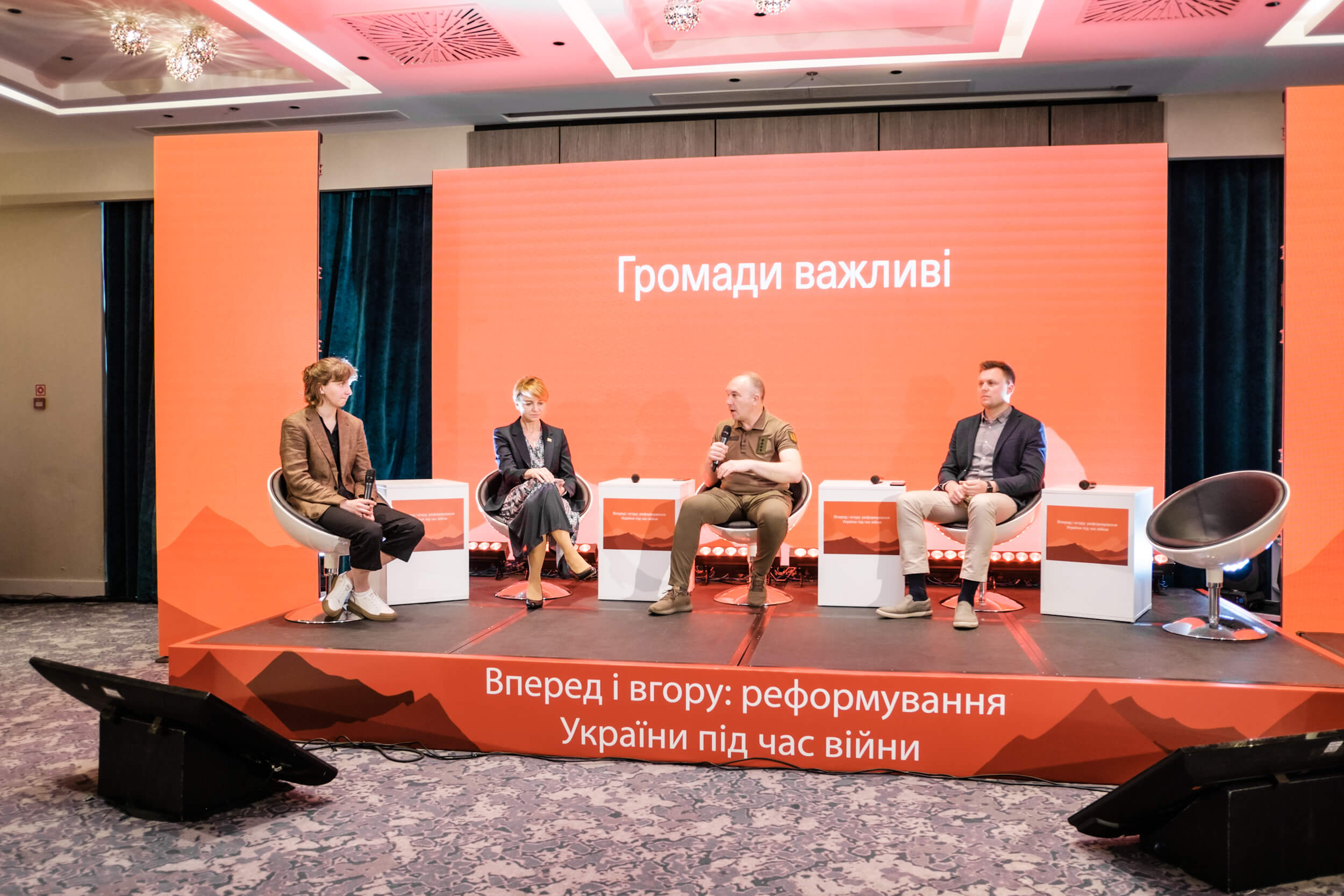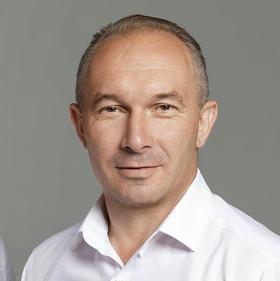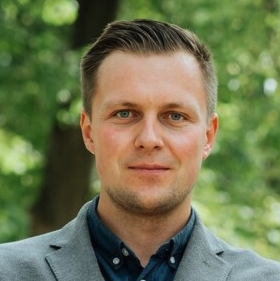As part of the International Conference “Forward and Upward: Reforming Ukraine During the War” organized by the NGO Vox Ukraine with the support of the National Endowment for Democracy (NED), a panel discussion titled “Communities Matter” was held. The discussion featured the participation of Oleksandra Keudel, assistant professor at KSE, Bohdan Kelichavyi, head of the Kopychyntsi city community (Ternopil region), Yurii Bova, head of the Trostianets city community (Sumy region), and Halyna Skipalska, director of the HealthRight International representation in Ukraine. We present the accounts of the heads of two very different communities on how they changed their work after the full-scale invasion. The full panel and other speakers’ speeches can be heard in the video recording.
The main challenges facing communities
Yurii Bova, head of the Trostianets city community, Sumy region (this community spent over a month under Russian occupation in February-March 2022): Our city, Trostianets, was occupied on February 24. Literally, within a few hours of the invasion beginning, the Russian troops entered and established several headquarters in our area. It was a Western Military District army with hundreds of pieces of military equipment. The tank army, the Kantemir Division, the Taman Division, etc., were all stationed in Trostianets, ready to destroy anything that might pose a threat to them. Our main task was to evacuate people.
We thank Alina Krupyanyk, a Reform Index project assistant, for transcribing the conversation.
People realized that war was a serious matter, posing a severe threat to life and bringing about a complete change to the way of life because you now had to constantly safeguard your life, thinking about how to protect the lives of those around you, your loved ones. Our city was under occupation for a month, without water, electricity, or anything else. People melted snow to provide water for their children. Those who knew where the nearest water was went there, risking their lives. Preserving lives during the war was the most critical challenge.
We found the diary of a Russian soldier. On March 3, 2022, he wrote about entering the city and being deployed in one of the stores. He wanted to bring back as much as possible for his wife but could only find a bag and a blender because everything else had been stolen. In two weeks, the city had been completely looted. Then, they were pushed out of the town, shooting back, so the consequences of this were horrific. The city’s asset destruction was estimated at $120 million. Furthermore, no municipal equipment was left: computers, vehicles, transportation, bolts, or wrenches… So, the second major challenge is the aftermath of the war.
Today, Ukraine in the east and Ukraine in the west are two different Ukraines. Everything has been destroyed in our region. Can you imagine going out in Kyiv today and finding 99% of businesses not operating? There’s nothing left; everything has been looted. What do you do then?
There was a pressing need for rapid recovery after the de-occupation. This was crucial. We understood that some residents had left, businesses were unable to operate normally, and our task was to swiftly restore life in every settlement. I never stepped into my office for four months, working with people from morning till night out on the streets. We distributed humanitarian aid and delivered generators and building materials… We achieved about 50% of what we had planned. But thanks to these activities, people returned. They can see that something is changing in their community. There are examples of neighboring communities where, unfortunately, people are leaving. They don’t trust the authorities. They don’t believe something’s being done; they are just disappointed.
Local governance plays a significant role in the liberated territories. For example, there is a chocolate factory owned by Mondelez in Trostianets. The facility was seized, vandalized, and looted. After the de-occupation, representatives of the city council were the first to enter there, setting up security, conducting demining, and so on. Then, the City Council told the investors they’d done everything they could, including providing security for three months, so it was time for the owners to return, get their security measures in place, and start rebuilding. At the moment, the factory is operational. In my opinion, those planning to do something in the future, ten years from now, will not gain anything. However, those who invest and start working today are the ones who will succeed.
In summary, wartime perceptions and post-war reconstruction are two very important and distinct challenges.
Bohdan Kelichavyi, head of the Kopychyntsi city community, Ternopil region: The challenges in our communities vary. Our challenges primarily involved an increase in the number of people. Our hospital received many patients on the first day: from Irpin, Bucha – everyone who could leave Kyiv. Later, there were new waves of people. Personally, my family hosted a Crimean Tatar family and another family from the city of Trostianets in the Sumy region.
The integration of internally displaced persons occurs in several stages. For instance, two families were traveling in two cars through the green corridor from Makariv. One family reached us, while the other remained in the so-called “green corridor.” While driving, they saw the hospital on their way and stayed with us because the driver was wounded. These are immediate needs. Initially, people need food, warmth… Some people arrived at our location wearing just slippers. Wounded individuals came as well. Next, we had to accommodate people and, later on, help them find employment. This is crucial because many people left the country despite finding comfort with us due to a lack of job opportunities.
We addressed the housing problem in the following way: Initially, we used our city institutions. We would close them and then reopen them for internally displaced persons. Then, there were collective centers. We’re now shifting our paradigm because we want to get people out of collective centers and work on building or reconstructing individual buildings so that people can live separately and integrate into society. For this, we engage international partners. Collaboration with them is one of our priorities.
The issue of employment is also very important. If someone couldn’t find work here, they usually didn’t return to the east but headed west toward Europe. So, we strategically decided that our region should retain as many Ukrainians as possible in a qualitative and non-coercive manner. We want them to stay within our economy, education network, healthcare system, etc., so they don’t leave for other regions. That’s why we are working on improving our capacity in hiring people and relocating businesses.
One of the essential challenges for us is some non-acceptance of “newcomers” – when “strangers” come to a small community. Even though they are Ukrainians and sometimes even speak Ukrainian better than we do in Halychyna, there is still a difference in attitude. As a community, we realize that we need to address this issue of non-acceptance.
We launched the #pryvitnikopychyntsi hashtag and wrote daily about families that had moved to our area and what they were doing so that residents could get to “know” them better. We also organized many integration-oriented, cultural, and educational events and provided assistance. Our humanitarian headquarters works not only for our community but also for other communities.
On the valuable experience that enables an effective response to today’s challenges
Yurii Bova: Our team is the main factor that allows us to cope. The level of reconstruction in each city depends on those who organize this work. It doesn’t depend on individual residents because they have their own role of helping the Ukrainian Armed Forces, weaving nets, delivering food, and so on. Our task is to find resources. For example, we’ve attracted around 100 million hryvnias to the city – almost half of the city’s budget.
For instance, the Russians simply shot our hospital with tanks at close range and smashed 736 windows (the hospital had recently been renovated; we had reformed and modernized it as part of decentralization). The state provided about 150 windows; we got over 500 more through our connections with partners, friends, etc. You open your phone book and start dialing. That’s how active local self-government is today.
Bohdan Kelichavyi: International donors are very important to us. I worked with them previously before joining local self-government. It feels very unusual for me to go, say, to Kyiv because since the beginning of the full-scale invasion, we’ve been entirely focused on our Western partners, receiving foreign delegations. However, it’s heartening to see Kyiv recovering, with more events taking place here. Everything’s relative. While Yurii perceives Kyiv as a city where everything works, there’s peace and tranquility; it was quite worrisome for us to come here. Yes, we all share the experience of blackouts and the losses of our soldiers and mobilized citizens, but the specific challenges in each community are different. The next task is to help the military reintegrate into society. This will be the focus of all donor and state organizations, as well as communities, including our own community.
Attention
The authors do not work for, consult to, own shares in or receive funding from any company or organization that would benefit from this article, and have no relevant affiliations





